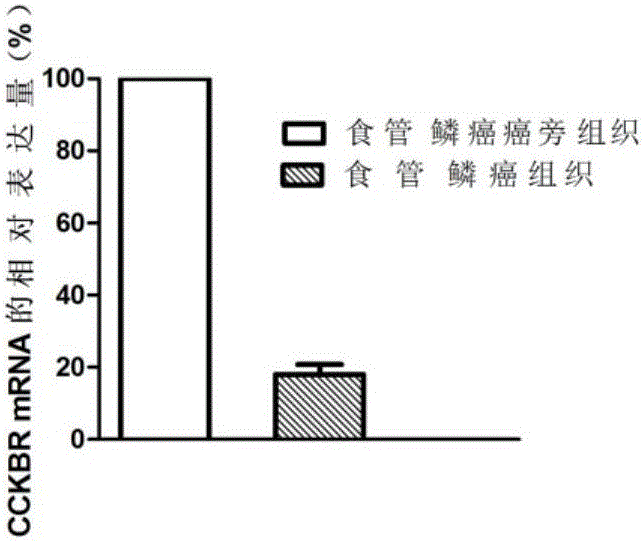Molecular marker of esophageal squamous carcinoma
A technology of esophageal squamous cell carcinoma and drugs, applied in the field of biomedicine, can solve problems such as limited value and difficulty in early diagnosis of esophageal squamous cell carcinoma
- Summary
- Abstract
- Description
- Claims
- Application Information
AI Technical Summary
Problems solved by technology
Method used
Image
Examples
Embodiment 1
[0063] Example 1 Screening for gene markers associated with esophageal squamous cell carcinoma
[0064] 1. Sample collection
[0065] Paracancerous tissues and esophageal squamous cell carcinoma tissue samples were collected from 6 cases of esophageal squamous cell carcinoma. All the above specimens were obtained with the consent of the organizational ethics committee.
[0066] 2. Preparation of RNA samples ((use QIAGEN tissue RNA extraction kit for operation)
[0067] Take out the tissue samples frozen in liquid nitrogen, put the tissue samples into a pre-cooled mortar for grinding, and extract and isolate RNA according to the instructions in the kit. details as follows:
[0068] 1) Add Trizol and place at room temperature for 5 minutes;
[0069] 2) Add 0.2ml of chloroform, vibrate the centrifuge tube vigorously, mix well, and place it at room temperature for 5-10min;
[0070] 3) Centrifuge at 12000rpm for 15min, transfer the upper aqueous phase to another new centrifuge...
Embodiment 2
[0083] Example 2 QPCR sequencing to verify the differential expression of CCKBR gene
[0084] 1. Large-sample QPCR verification of differential expression of CCKBR gene. According to the sample collection method in Example 1, 50 cases of esophageal squamous cell carcinoma adjacent tissues and 50 cases of esophageal squamous cell carcinoma tissues were selected.
[0085] 2. The RNA extraction steps are the same as in Example 1.
[0086] 3. Reverse transcription:
[0087] Using a 25 μl reaction system, take 1 μg total RNA for each sample as template RNA, and add the following components to the PCR tube: DEPC water, 5× reverse transcription buffer, 10 mM dNTP, 0.1 mMDTT, 30 μM OligodT, 200 U / μl M-MLV, template RNA. Incubate at 42°C for 1 hour, then centrifuge briefly at 72°C for 10 minutes.
[0088] (3) QPCR amplification test
[0089] Primer design
[0090] The primer sequence of CCKBR gene is:
[0091] Forward primer: 5'-TTGGTTGCCAGTTTATAG-3' (SEQ ID NO.3)
[0092] Reve...
Embodiment 3
[0103] Overexpression of embodiment 3CCKBR gene
[0104] 1. Cell culture
[0105] Human esophageal squamous cell carcinoma cell line KYSE150 was incubated at 37°C and 5% CO in DMEM containing 10% fetal bovine serum and 1% P / S. 2 , Cultivated in an incubator with a relative humidity of 90%. Change the medium once every 2-3 days, and use 0.25% EDTA-containing trypsin for routine digestion and passage.
[0106] 2. Overexpression of CCKBR gene
[0107] 2.1 Construction of CCKBR gene expression vector
[0108] According to the coding sequence of CCKBR gene (as shown in SEQIDNO.1) design amplification primer, primer sequence is as follows:
[0109] Forward primer: 5'-CCGAAGCTTGCCACCATGGAGCTGCTAAAG-3' (SEQ ID NO.7)
[0110] Reverse primer: 5'-CGGGCGGCCGCGCCAGGGCCCAGTGTGCTA-3' (SEQ ID NO.8)
[0111] The coding sequence of the full-length CCKBR gene was amplified from the cDNA library of adult fetal brain (clontech company, product number: 638831), and the above cDNA sequence was...
PUM
 Login to View More
Login to View More Abstract
Description
Claims
Application Information
 Login to View More
Login to View More - R&D
- Intellectual Property
- Life Sciences
- Materials
- Tech Scout
- Unparalleled Data Quality
- Higher Quality Content
- 60% Fewer Hallucinations
Browse by: Latest US Patents, China's latest patents, Technical Efficacy Thesaurus, Application Domain, Technology Topic, Popular Technical Reports.
© 2025 PatSnap. All rights reserved.Legal|Privacy policy|Modern Slavery Act Transparency Statement|Sitemap|About US| Contact US: help@patsnap.com



